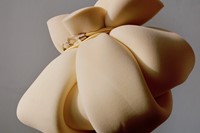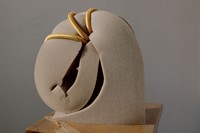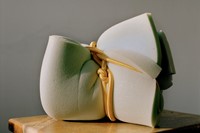Encompassing photography and sculpture at once, Tine Bek’s series Komfort Skulptur breathes new meaning into the mundane materials which surround us
How can we characterise the relationship between photography and sculpture? Between art and the domestic? Between luxury materials and fabric scraps? These are the central questions prompted by Glasgow-based artist Tine Bek’s new photography series Komfort Skulptur, the latest development in her ongoing project The Vulgarity of Being Three-Dimensional.
Foam rubber and sponge cloths are Komfort Skulptur’s unassuming protagonists. In her series, Bek elevates everyday household fabrics, weaves them together, twists them out of shape, and carefully situates them on top of wooden stools in order to capture the materials in their full complexity. It is through these pink, beige, yellow and brown creations that Bek breathes new meaning into the surfaces that surround us on a day-to-day basis.
The idea behind Komfort Skulptur developed after Bek started reading about the history and evolution of furniture. “I spent a lot of time researching places that sold different forms of household equipment,” Bek recalls. “I started ordering some on eBay, and later found a local store in Glasgow where I regularly went and asked if they had any good fabric cuts. The shop owner never quite understood what I was doing. He kept saying that if I needed to photograph the foam I could just do it there and then. He probably thought I was an idiot for buying so many useless scraps.” After accumulating a range of different textiles, Bek started transforming her found objects into the soft, architectural sculptures that make up her thought-provoking series.
The sophisticated sculptural formations were inspired by the window displays of Denmark’s oldest confectionary, Conditori La Glace. Bek is particularly moved by the time and attention that goes into decorating the elaborate cakes, which are then sold and eaten. “I wanted Komfort Skulptur to mimic these complex forms in a down to earth, almost humorous way,” Bek says. “The series is really documentation of temporary sculptures that were not meant to last, and reflects on the inevitable tension between wanting to immortalise an unsettled shape.” Komfort Skulptur, although intricately complex, has roots in the mundane, the trivial. It serves as a reminder that fine art sculptures don’t have to be made of long-lasting materials like marble or bronze. They can exist as flimsy, temporary textures that take their shapes from mille-feuilles or Paris-Brests.

“Each sculpture is carefully staged,” Bek says. “I spent a lot of time fiddling with the equipment to get the right set-up. You could almost say that the photographs capture a performative act as the artworks only keep their shape for a brief moment; they will not withstand time.” It is this multi-media collaboration which lies at the heart of Komfort Skulptur. Bek uses photography not just to record her sculptural creations, but rather to produce artistic crossovers that open up new spaces in which to appreciate the beauty of the banal.






